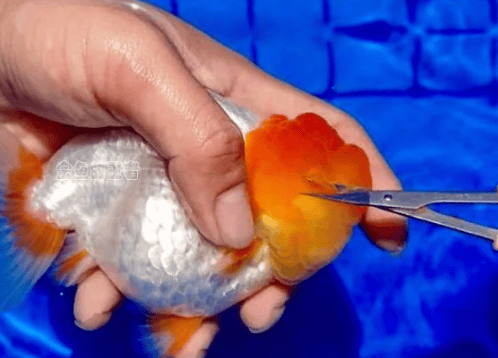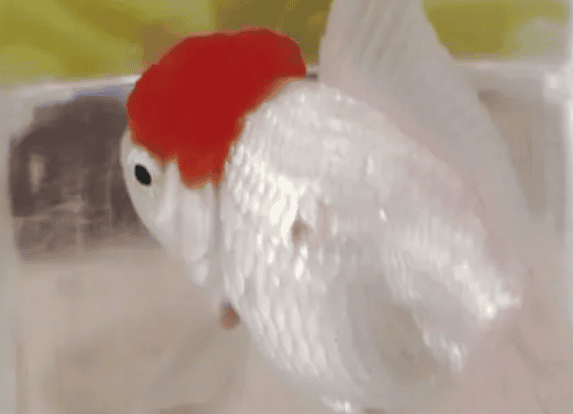During the treatment of fish diseases, it is often necessary to manually catch the fish to apply the medicine. For example, when applying red lotion to treat white spots on goldfish, or dealing with white cotton wool on head tumors, special attention needs to be paid to some operational details. Here, we take the treatment of rotten meat on the surface of fish as an example to explain in detail.

The treatment steps are as follows: First, prepare iodine. (Or alternative medicines such as red syrup, potassium permanganate crystals, etc.), water and three clean cotton swabs. Then, gently remove the sick fish from the water, and ensure that the fish body remains in a position with its head up and its tail down, so that it is easier to operate. Next, hold the fish steadily with one hand while using a cotton swab with the other hand to carefully remove any rotten muscle tissue.
After completing this step, rinse the wound gently with water to ensure it is clean. Then, use a new, clean cotton swab to blot the wound and surrounding area of moisture. Next, dip a cotton swab into an appropriate amount of iodine and apply it evenly on the wound (or sprinkle potassium permanganate crystals directly on the wound). Finally, use clean water to slowly rinse the fish body, starting from the head, and rinse away any excess iodine on the wound.
After completing the above treatment, the sick fish can be gently returned to clean water for recuperation. During the recovery period, clean water quality is crucial, which helps the wound heal quickly. It is worth mentioning that whether you use iodine, potassium permanganate crystals or high-concentration potassium permanganate solution for treatment, you must ensure that these substances do not flow into the fish's gills to avoid adverse effects on the fish's breathing.
During the entire treatment process, be sure to keep the fish with its mouth upward, which is convenient for operation. When rinsing residual medicine with clean water, start from the head of the fish and gradually wash downward to avoid the medicine flowing into the gills. If you use red syrup to apply it, just be careful to prevent the red syrup from flowing into the fish's gills. There is no need to rinse it with clean water again afterwards. However, in order to ensure the effectiveness of the red potion, it is best to wait for a while before putting it back into the water. Let the red potion dry slightly before placing it in clear water. This will be more conducive to the recovery of the fish.

Sometimes, goldfish muscle decay does not start from the surface. Instead, it gradually expands from the inside out. At first, the inside of the fish's muscles may only be slightly red, but as the disease progresses, the color gradually deepens and spreads to the outside, eventually leading to complete muscle rot. Faced with this situation, in addition to the above-mentioned surgical operations, it is recommended to feed bait containing antibacterial ingredients to assist treatment. Whether the rot is caused internally or externally, feeding medicated bait during the recovery period can be beneficial.
It should also be noted that rotten muscles will affect the stability of goldfish body fluid concentration. Nutrients will leak into the water from the wounds, and fresh water may also enter the fish through the wounds, increasing its excretion burden. Therefore, applying potassium permanganate crystals directly to the wound can help the wound to scab, reduce the burden on the goldfish, and promote recovery.
Red potion also has a similar effect, but its effect is slightly inferior to potassium permanganate. If the traditional Chinese medicine gallnut is used, it can be powdered and can be directly stuffed into the affected area or applied to the wound. It can even be used as an auxiliary treatment for oral administration or boiled into a concoction and poured into the fish tank, which can exert astringent and hemostatic effects.
In addition, the traditional Chinese medicine Astragalus root has the effects of removing toxins and pus, diluting water and promoting muscle growth, and can enhance the phagocytic ability of white blood cells and improve immune function. Using astragalus as an auxiliary treatment drug after surgery for sick fish can also accelerate wound healing.
In foreign countries, some people spray propolis on fish wounds for treatment. This not only sterilizes and reduces inflammation, but also effectively isolates the wound from contact with water. In addition, adding an appropriate amount of salt to the water to adjust the osmotic pressure is also an effective auxiliary treatment method.

 扫一扫微信交流
扫一扫微信交流
发布评论